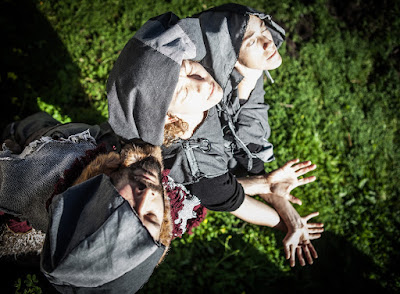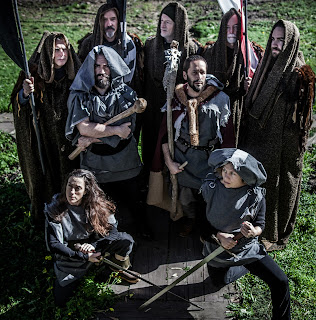BEOWULF
 |
| Nathaniel Justiniano, Ava Roy & Dana Ioga-Koga |
“Smell … Listen … Breathe.”
And a hundred-plus “mourners” all clad in black (i.e., the audience) leave the San Francisco Maritime Museum, heading toward the sounds of sad, wailing saxophones, tucked in the green hills and hidden among the giant trees with branches reaching to heaven as in prayer. Along the way of our silent, solemn trek above the setting sun of the Bay, a woman chants morosely tucked inside a rock; a robed man looks to the sky in fear, mouth open; and a woman in skins and cloth pulls on a rope emanating from the earth. And as the deep, haunting sounds of two conch shells answering each other’s blasts harken us further, we are told, “You have come because you felt the call, but you don’t know yet the latent horror.”
What we do know is that we are a part of another We Players, outdoor performance, this time at Fort Mason’s Aquatic Park and Chapel and performed in conjunction with Rova Saxophone Quartet and InkBoat (a physical theatre and dance company). We soon learn as we spread ashes on a grave marked by royal crown and robe that we are here to mourn the death of the great king and hero of ancient Geatland, Beowulf. We eventually retire to a funeral feast in the great Mead Hall, the Fort’s Chapel ably transformed to a community gathering spot for ancient Anglo-Saxons of a thousand years ago. There, we settle shoulder-to-shoulder on benches to learn and relish this great man’s wondrous feats and their effects on both the Geatish kingdom and its enemies.
The original poem Beowulf that many of us struggled in high school to read in its Old English form relates the cross-sea journey that Beowulf makes to save the Danes from a havoc-raising, man-eating monster named Grendel. The hero’s other-worldly strengths and bravery triumph as he rips first the giant arm and later the grisly head from the demon, also killing in a boiling lake Grendel’s raging and revenge-seeking mother. Back home in Greitland and as king ruling over fifty years of peace, the old man Beowulf heads out to fight an invading dragon with the help of a young warrior, Wiglaf. The dragon is defeated, but the hero king also finally succumbs.
 |
| The Cast of BEOWULF |
And it is at this point that the nine performers who are also co-creators pick up the story. Less narrative poem or dramatic play and more a combination, performance piece of music, dance, mime, chant, and poetry, their BEOWULF is structured to allow adapted glimpses of the original poem to be recalled from a wide variety of viewpoints beyond that of Beowulf’s — including those of Beowulf’s warriors, the victims of Grendel’s savage hunger, Grendel himself, and his mother.
Time and locations also mix and shift in the panoramic telling that happens often without words and through only the vibrant visuals performed by four actors on a raised stage between the rows of benched audience. In the form of a cross and with two ramped ends where actors crawl, wriggle, run, and drag themselves to its pinnacle, the stage has at its head an alter of sorts where the great head of the recently conquered dragon rests on high.
As various tales are recounted from different frames of reference, saxophones, clarinets, and drums accompany in sounds more often other-worldly than not. Staccato bursts, squawks, and squeals; puffs of wind and waves of the sea; and growls and groans float and fly from all directions in the mostly darkened arena with occasional pounds and booms that seem to emit from somewhere deep within the old, wooden walls around us. At one point, arguing and fighting Geats leave words behind and continue their verbal battle relying on the clicking, clacking, clucking that somehow are coming from instruments we have always knows as melodic woodwinds. Charlie Gurke, Jon Raskin, Larry Ochs, Bruce Ackley, and Steve Adams clothed in their own versions of early Middle Ages furs, hides, and rough robes become an integral part of the storytelling, offering a musical score like none any of us has likely ever heard nor will long forget.
Joining Justiniano and Iova-Koga as the performers of dance, mime, and acting are Ava Roy and Shinichi Iova-Koga (the latter two also serving as co-directors of this complex compilation of outdoor-indoor scenes). Each performer displays ongoing, intense concentration — often as if in a trance — as the motions of a storyline are ever-so slowly and painstakingly enacted with each taut muscle and raised vein playing its essential role. And then, each and all can suddenly explode with an energy that is startling in its power and speed as bodies whiz back and forth, roll and tumble, rise and fall. This time a sleeping warrior being eaten, next the extended arms of a dying monster, and then the drunken mob celebrating victory, each actor takes on several dozen, oft-unnamed roles that combine to relay why this king, now dead, is to be so revered and forever honored.
While many moments are to be held in awe as performed by the talented cast, a particular ballet-like sequence by Shinichi Iova-Koga as the injured and dying Grendel is particularly moving as his tucked toes and twisted limbs that are bent and rounded to point in all directions make their way slowly to his point of final demise. The pain dripping from each bead of sweat in his slow journey to death cannot help but remind us that even the cruelest, most hated of enemies still has elements of humanity within him to be pitied.
Much of the evening’s magic and mysticism is created through a lighting design by Allen Willner that allows another time, another world to rise before us as well as helps to direct our attention to the next sequence of related events. The properties of Yoshinori Asai and the costumes of Maria Chenut establish the kingdom of Geitland and its people around the year 1000, with bones, skulls, furs, and heavy woolen fabrics playing major parts.
The downside of this joint, multi-faceted production of BEOWULF is there is not always consistency in the flow and energy it generates to keep its audience fully engaged and involved (as witnessed by a number of obvious yawns around me as the evening progressed). There is also a point that the cacophonous instrumented sounds blaring all around come close to becoming monotonous. The mostly non-narrated set of short tales can begin to run together and seem repetitive and/or too long, even in their individual brevity. At a total of about two-and-a-half-hours, the total piece feels like some editing of a few sequences might be warranted.
But with those rather minor cautions, if one comes into BEOWULF open to something not a play but more of a multi-disciplined performance piece, then this production by We Players, Rova Saxophone Quartet & InkBoat is bound to fascinate and please. And, the somber and peaceful trek up and over in the setting sun among intense greenery above the San Francisco Bay is worth the price of the ticket in itself.
Rating: 3 E
BEOWULF continues through April 16 in a joint production by We Players, Rova Saxophone Quartet & InkBoat at Aquatic Park and Fort Mason Chapel, 1100 Bay Street, San Francisco. Tickets are available at www.weplayers.org.
Photo Credits by Lauren Matley

Leave a Reply